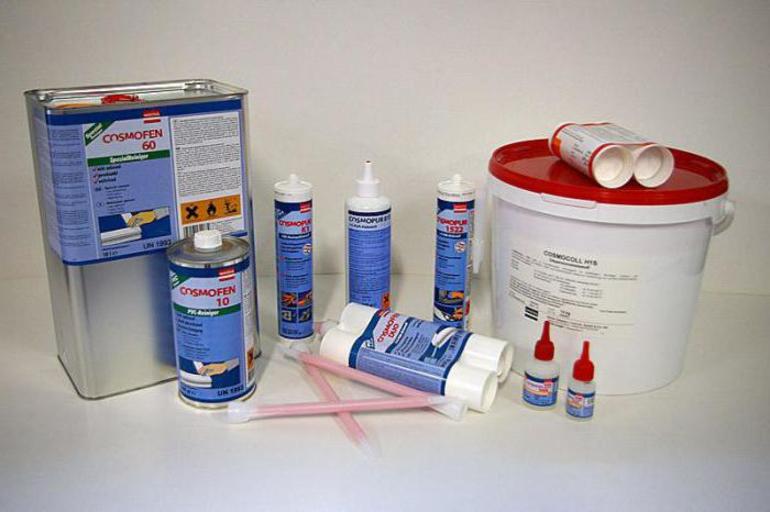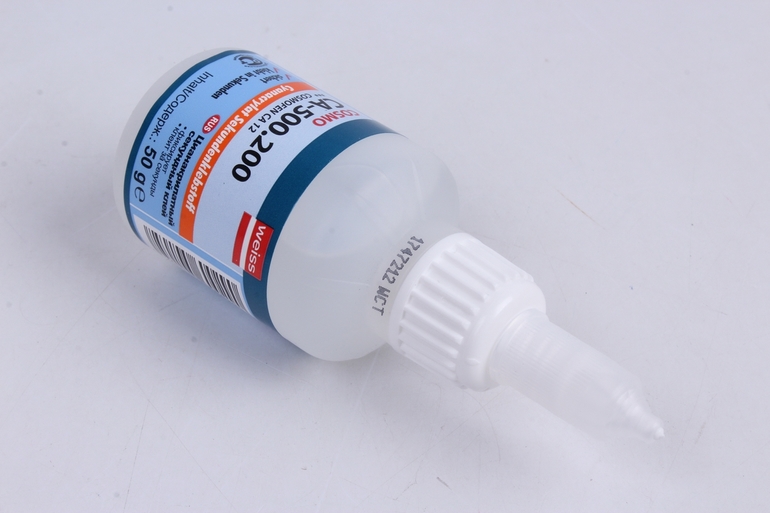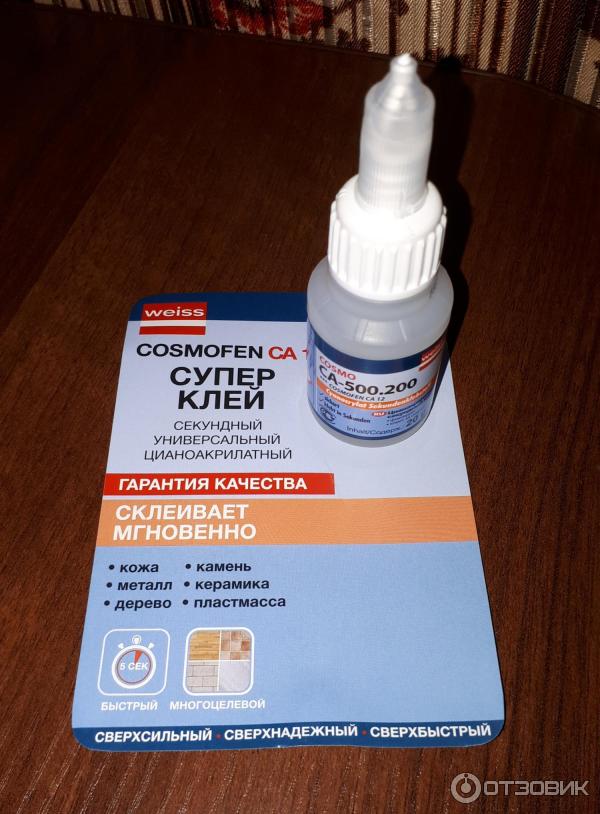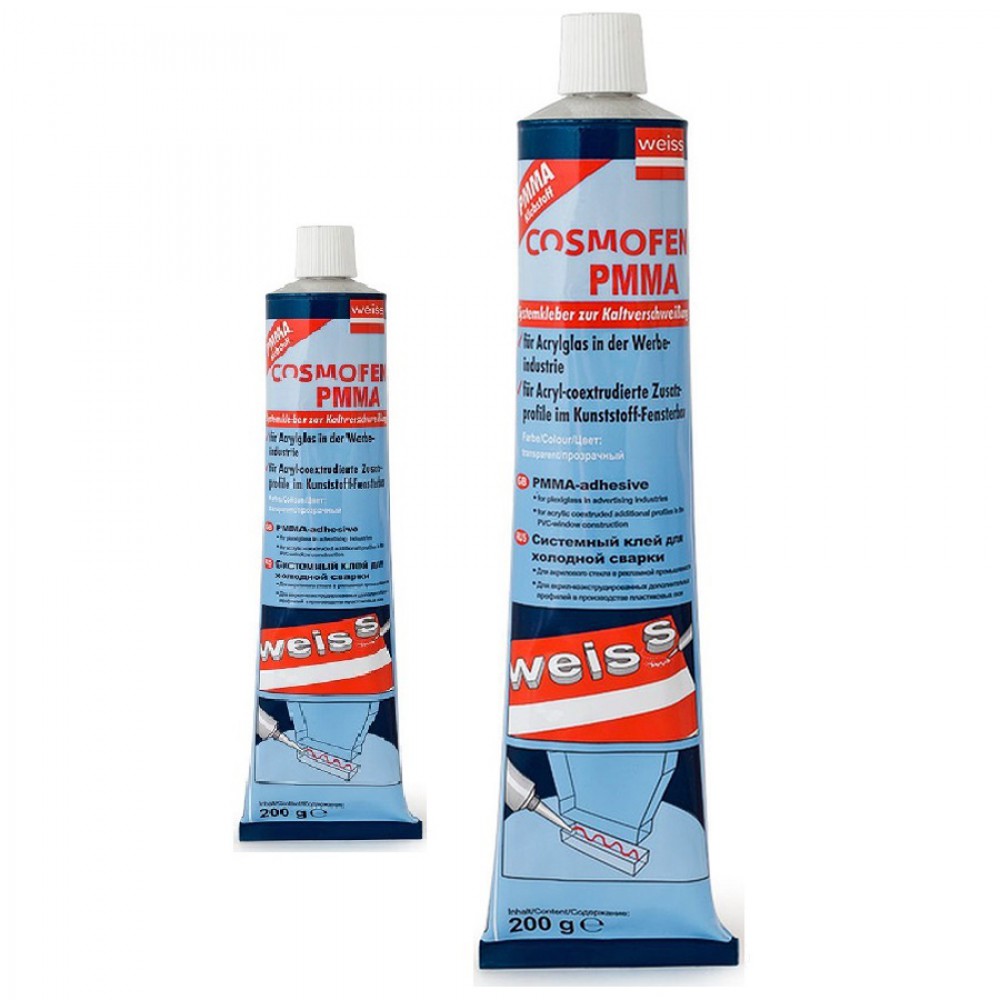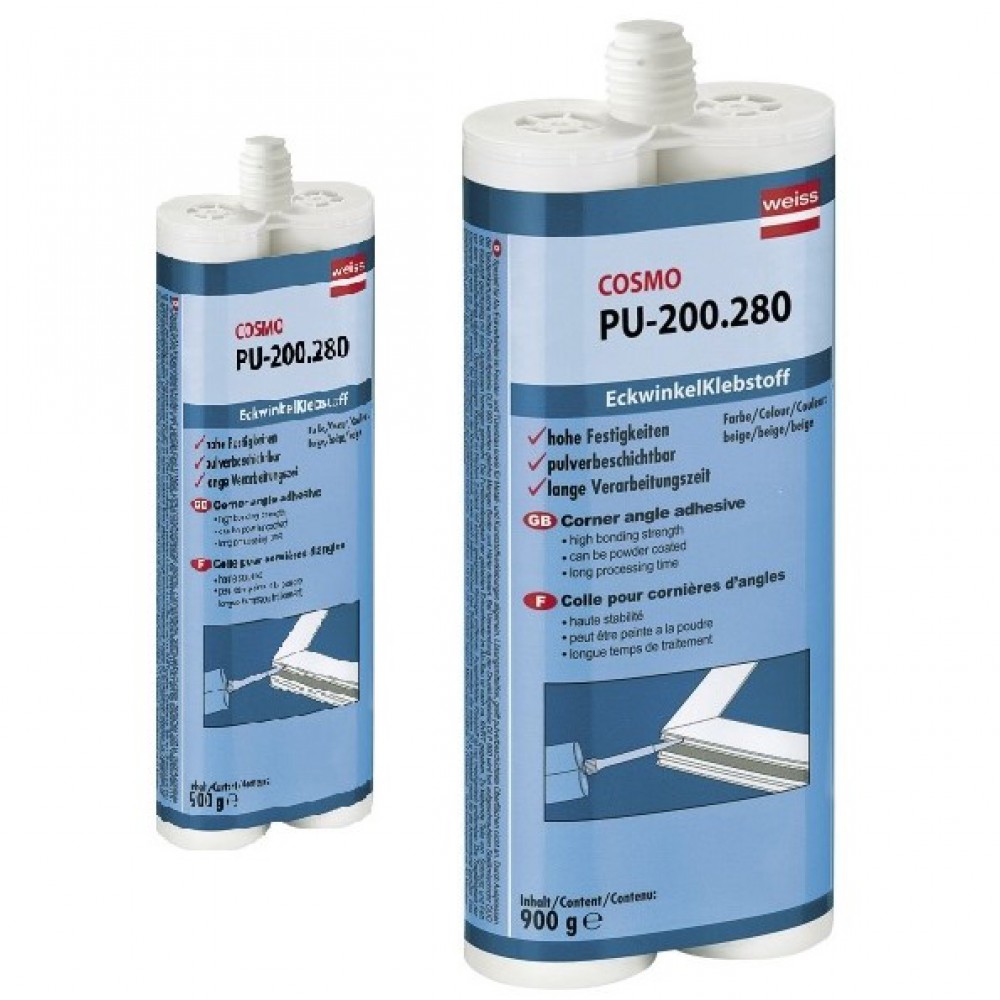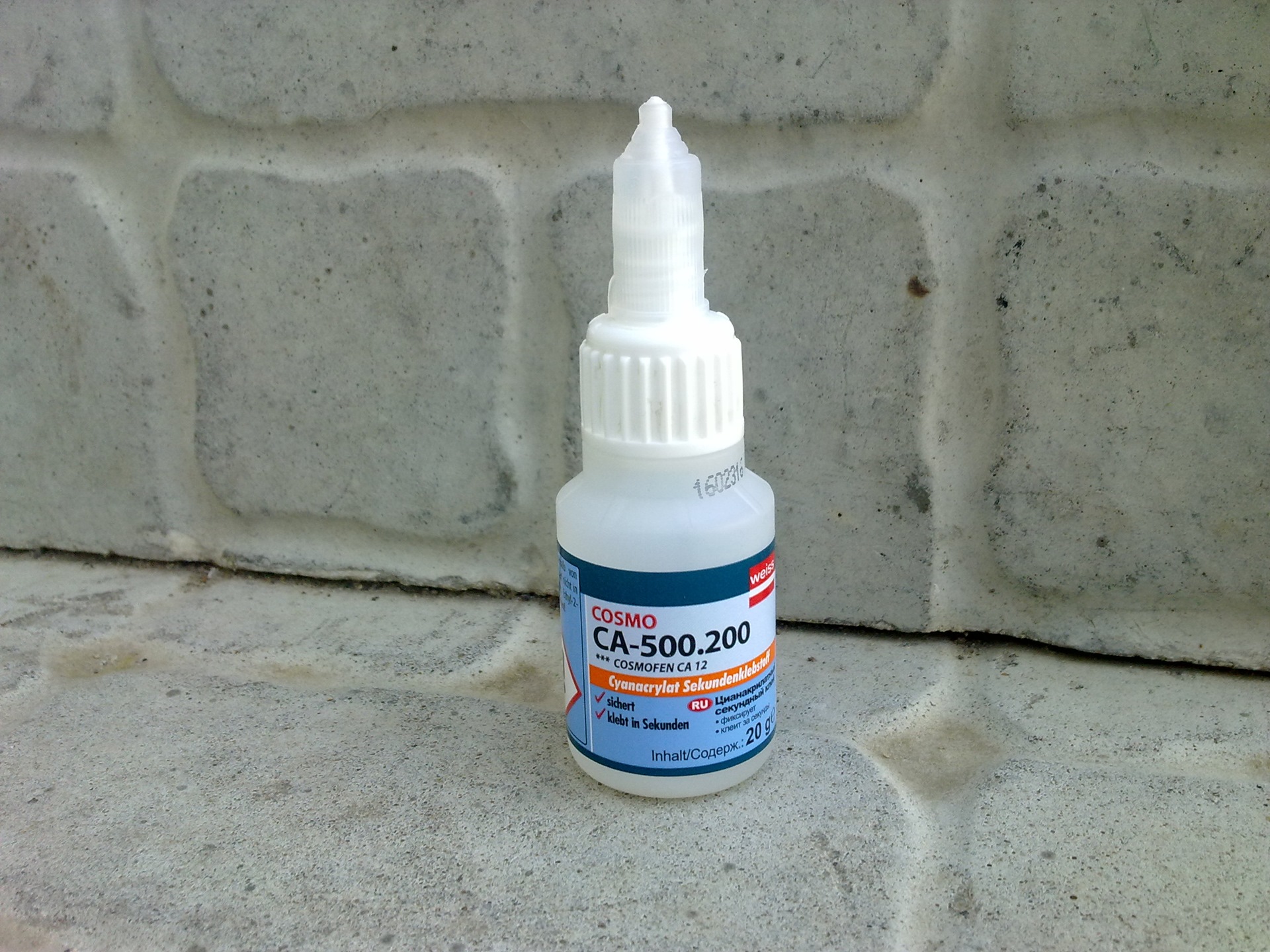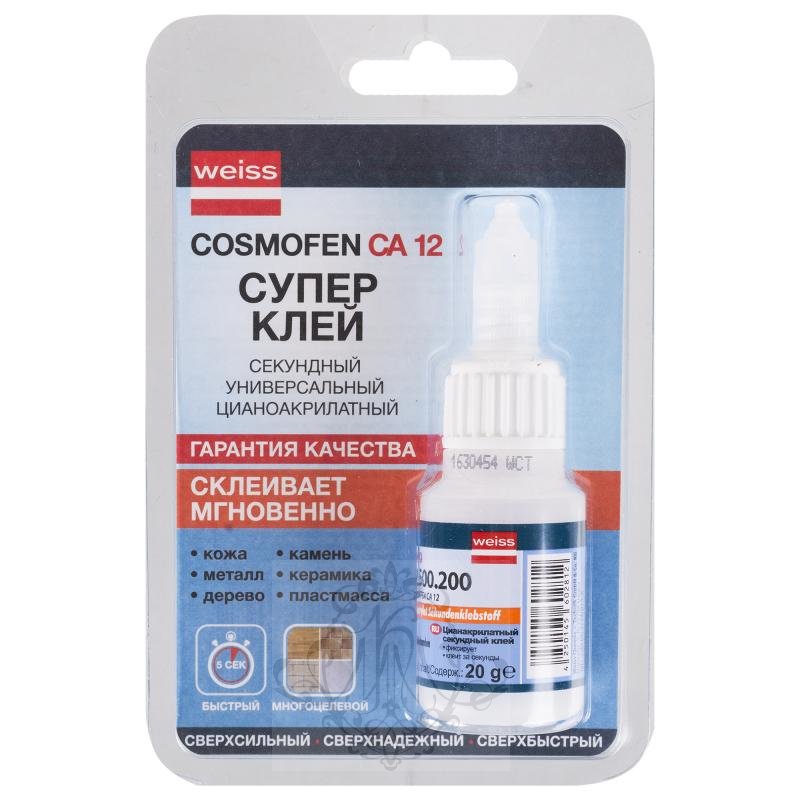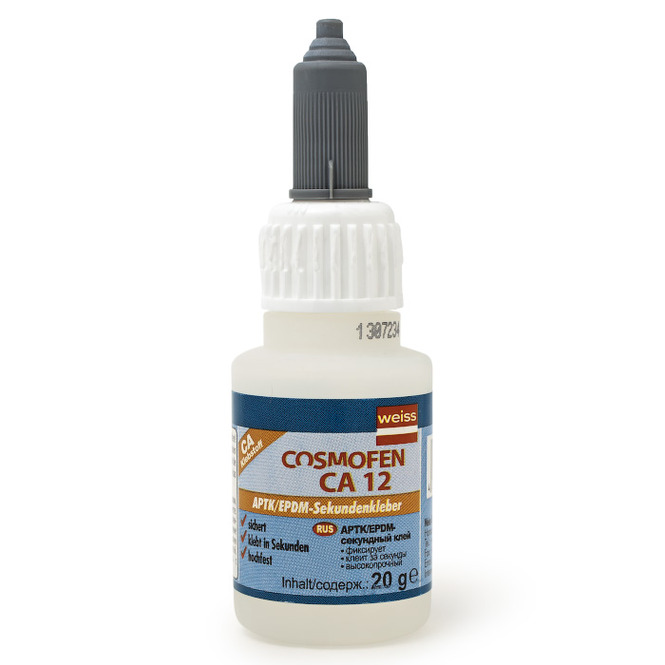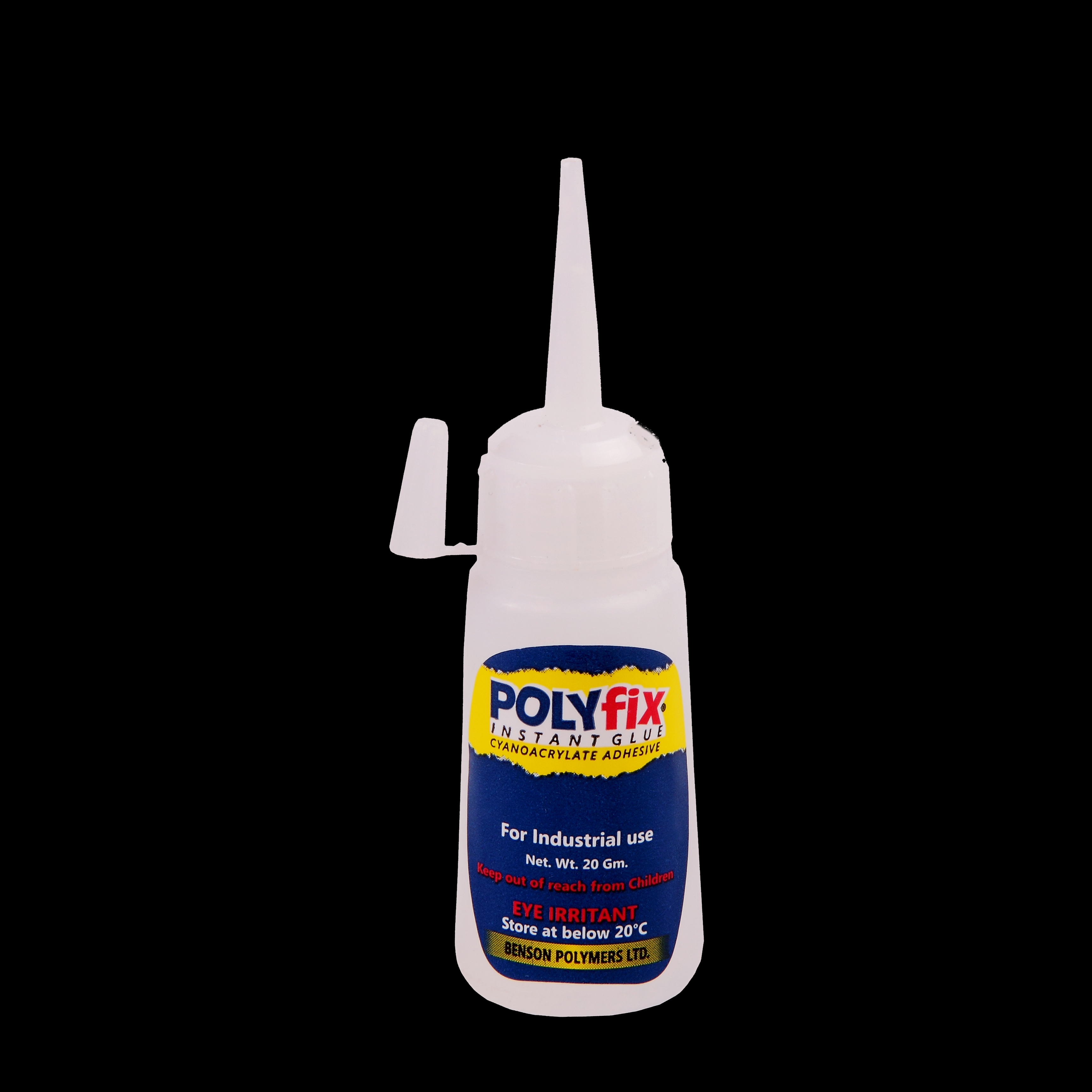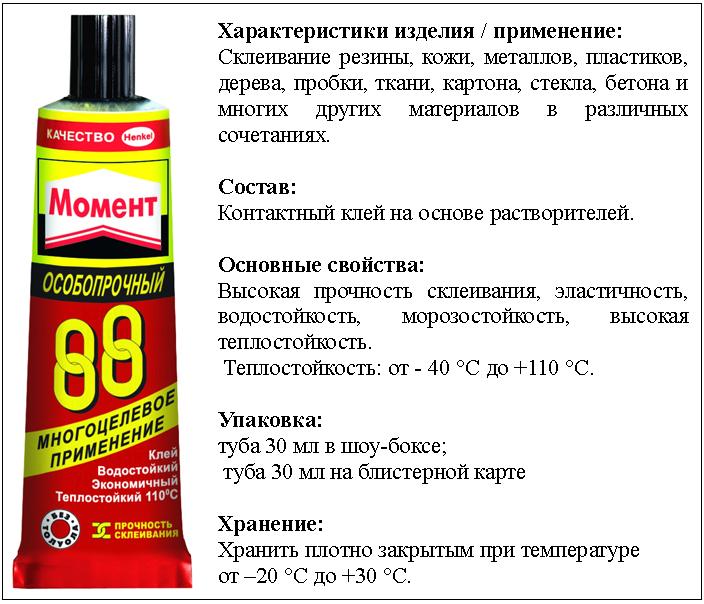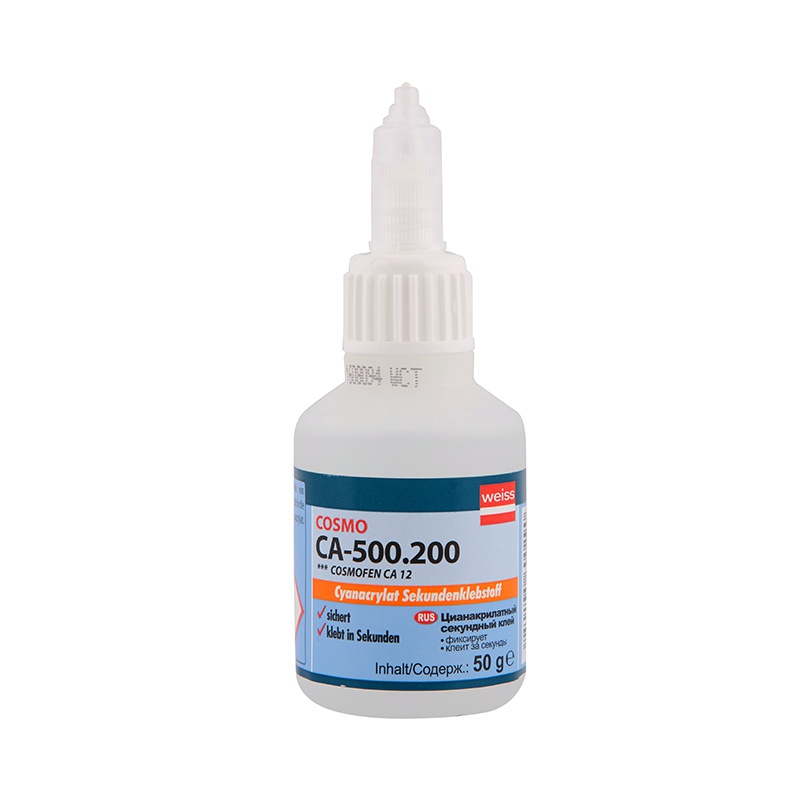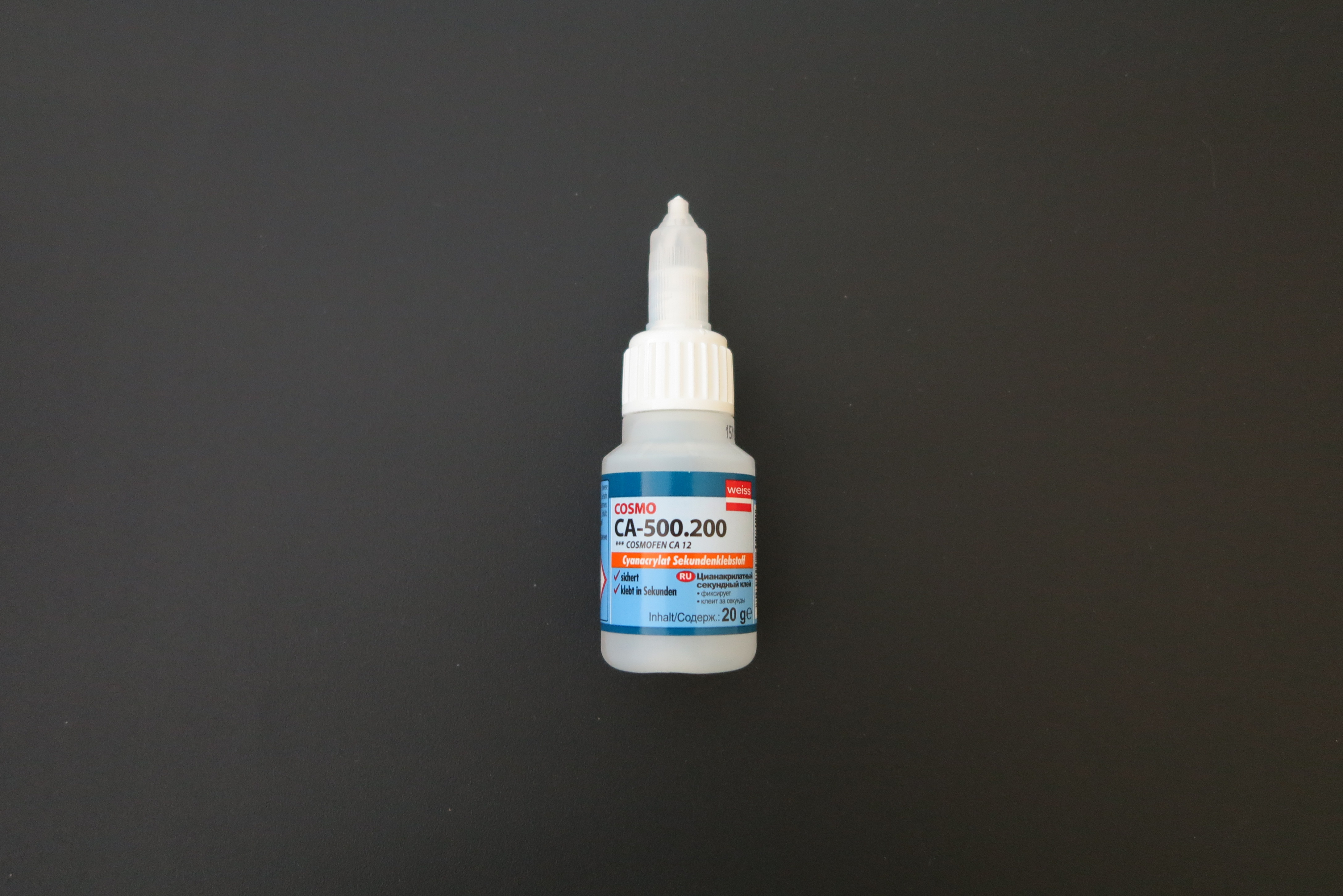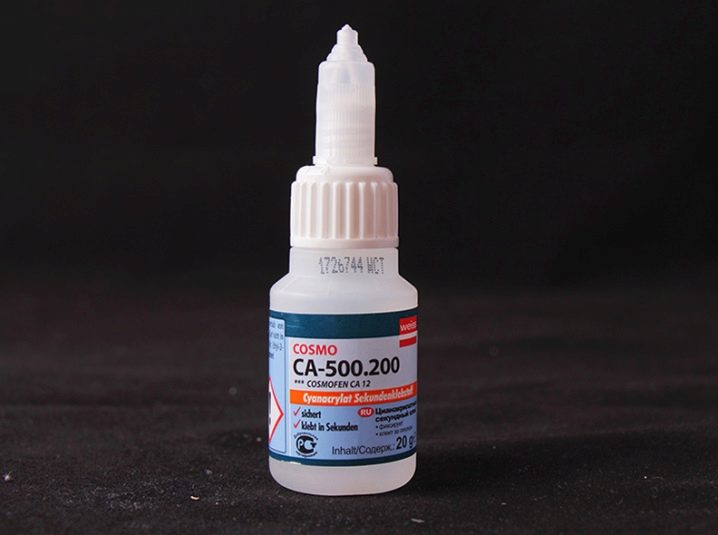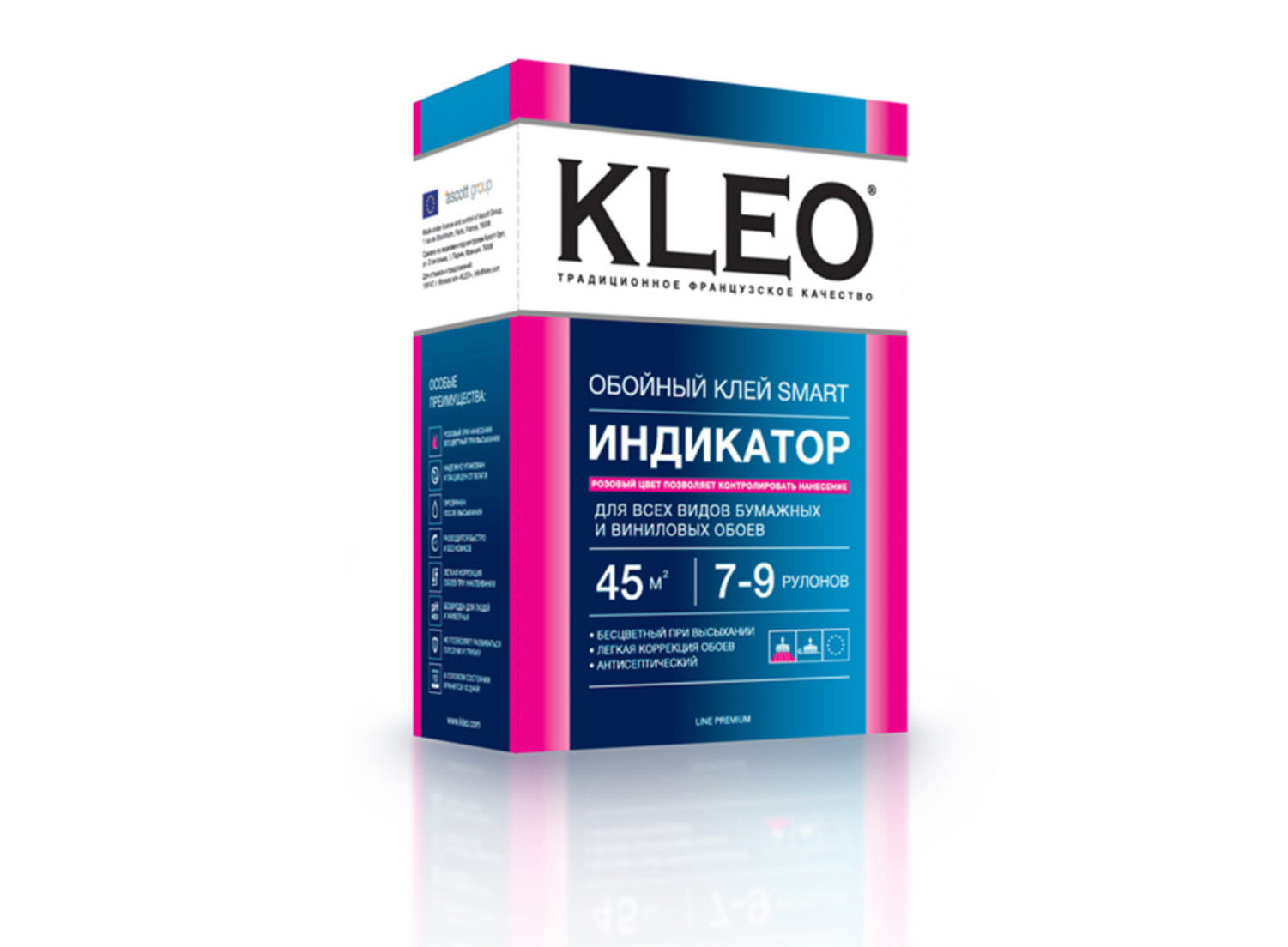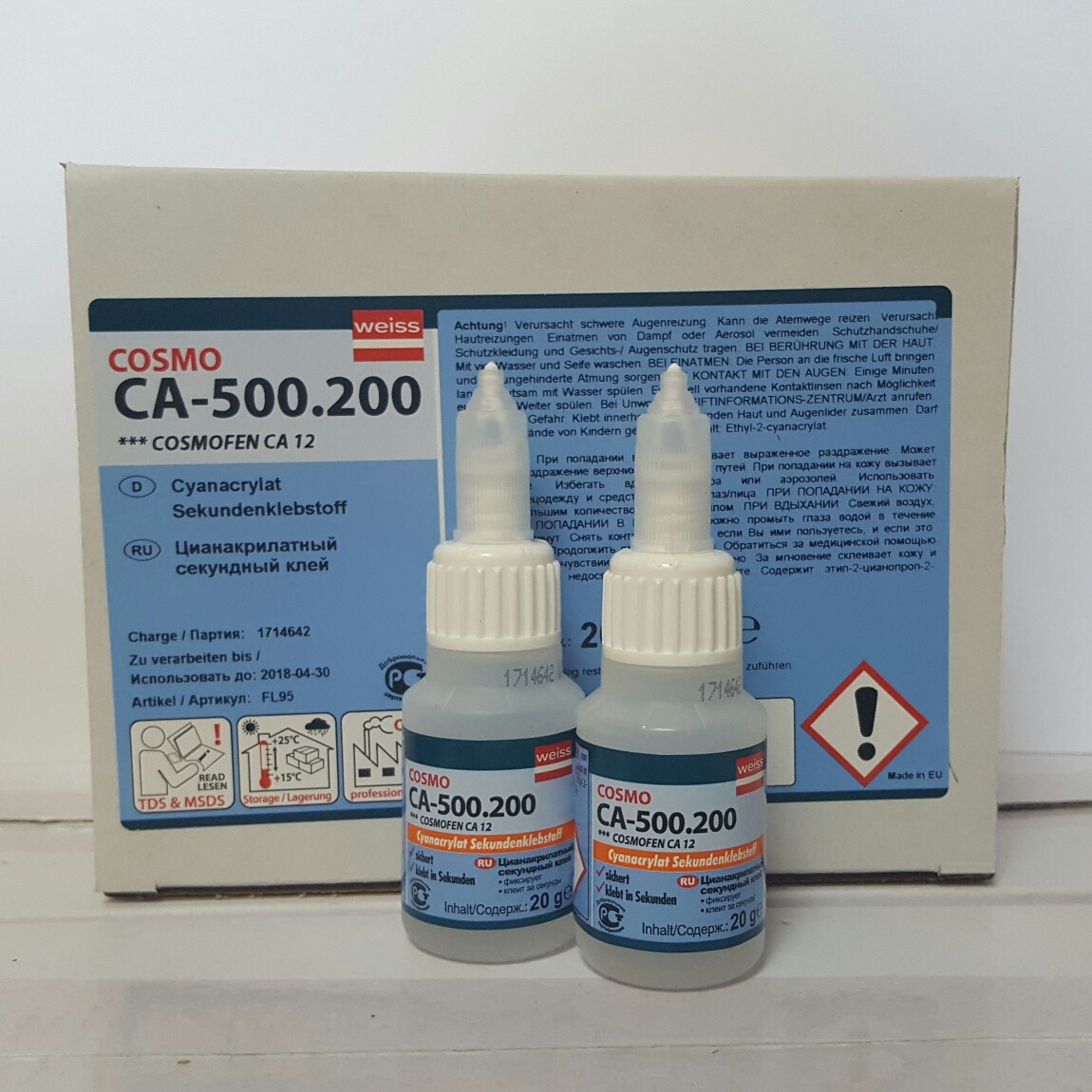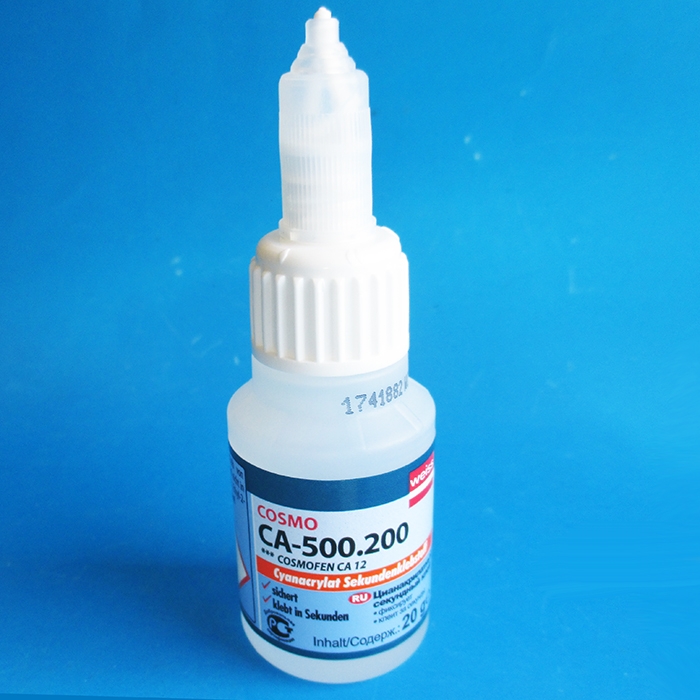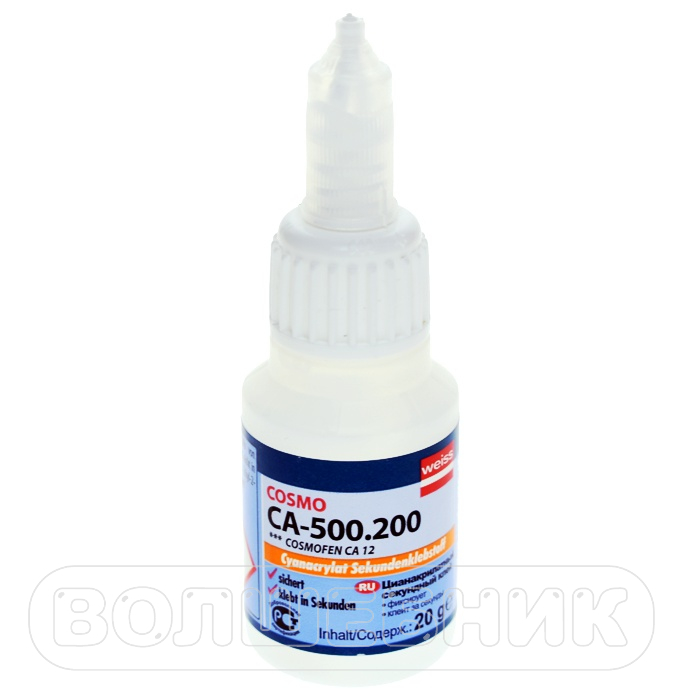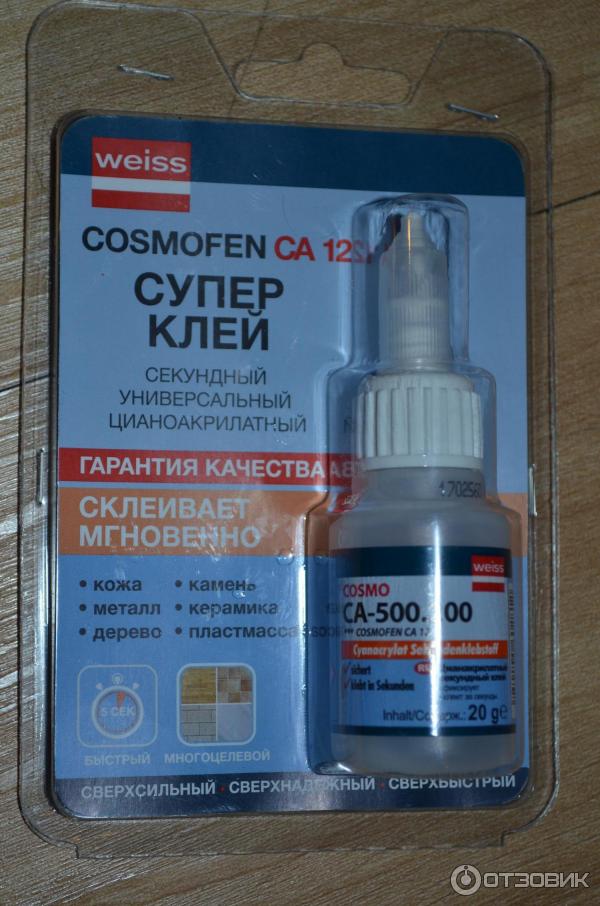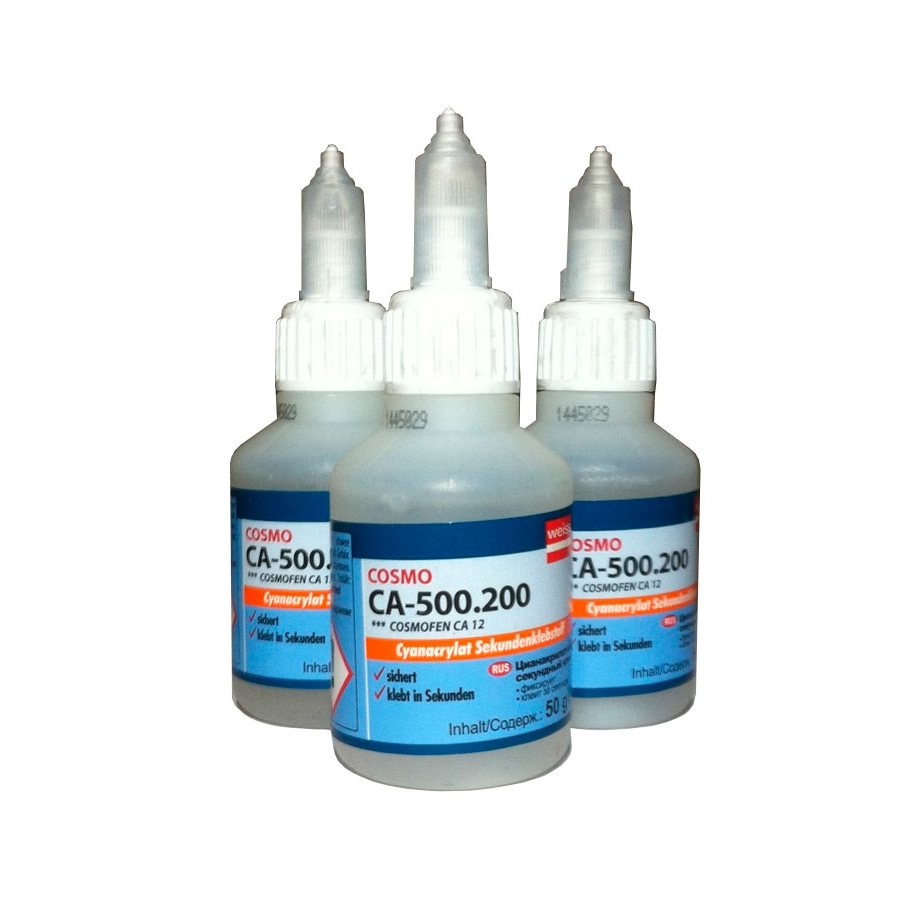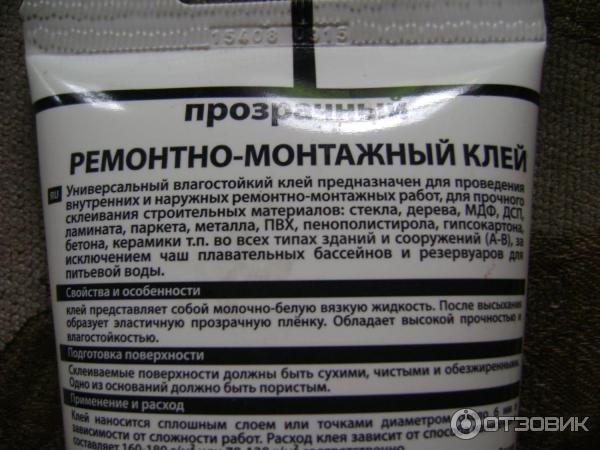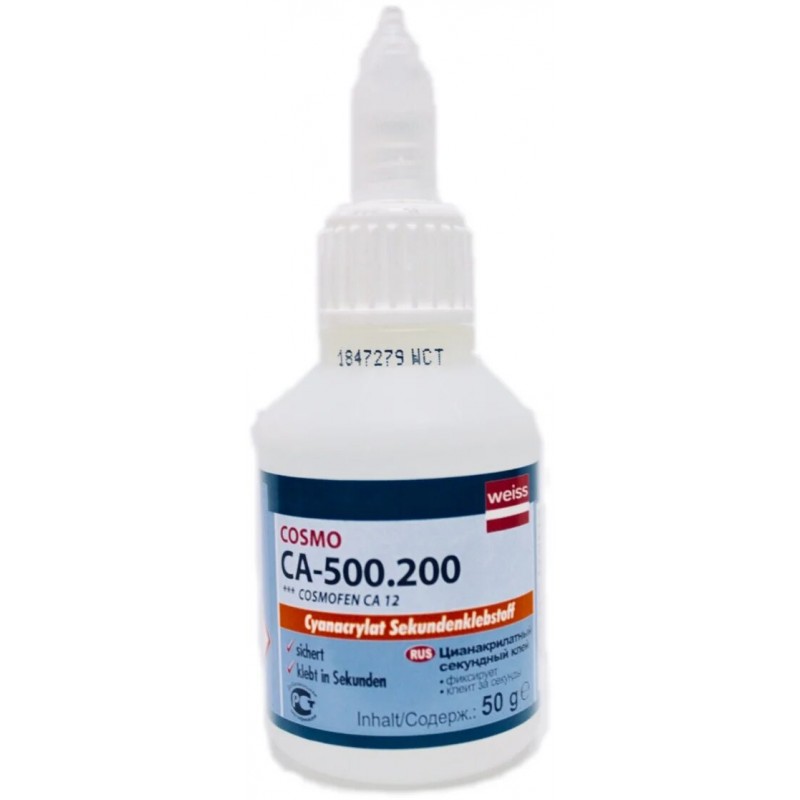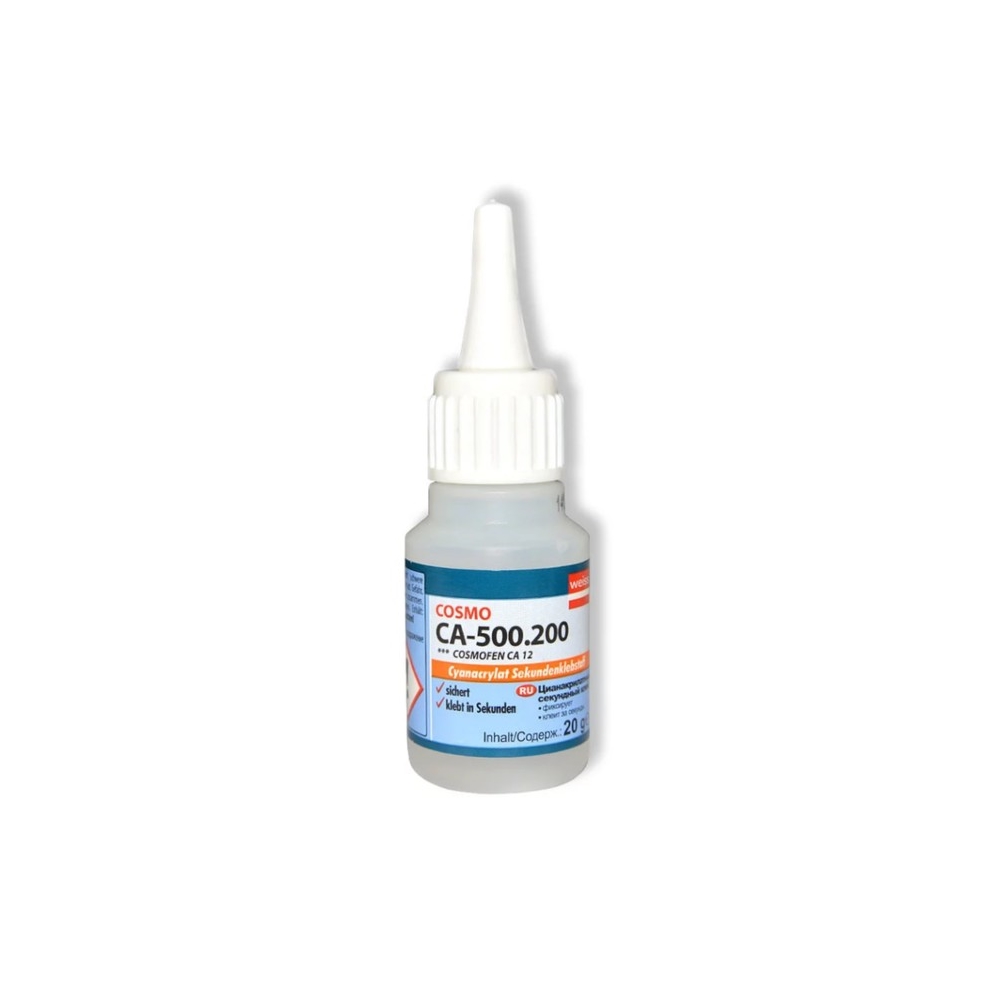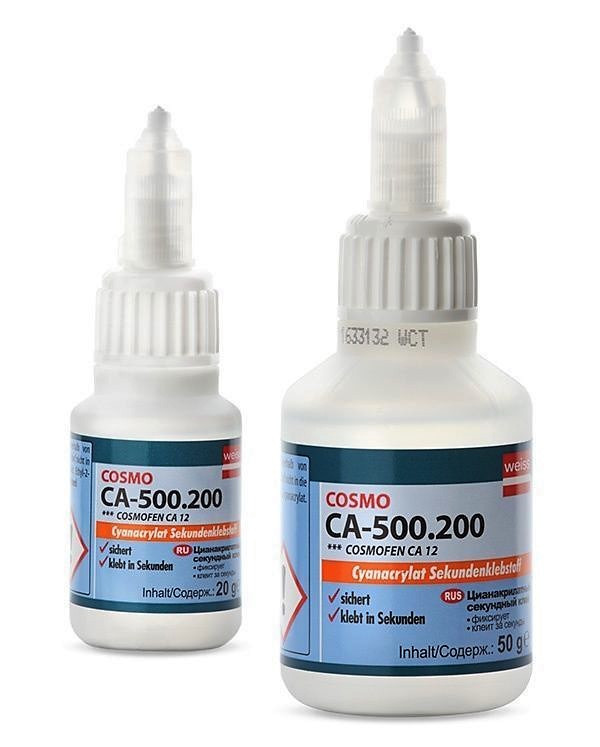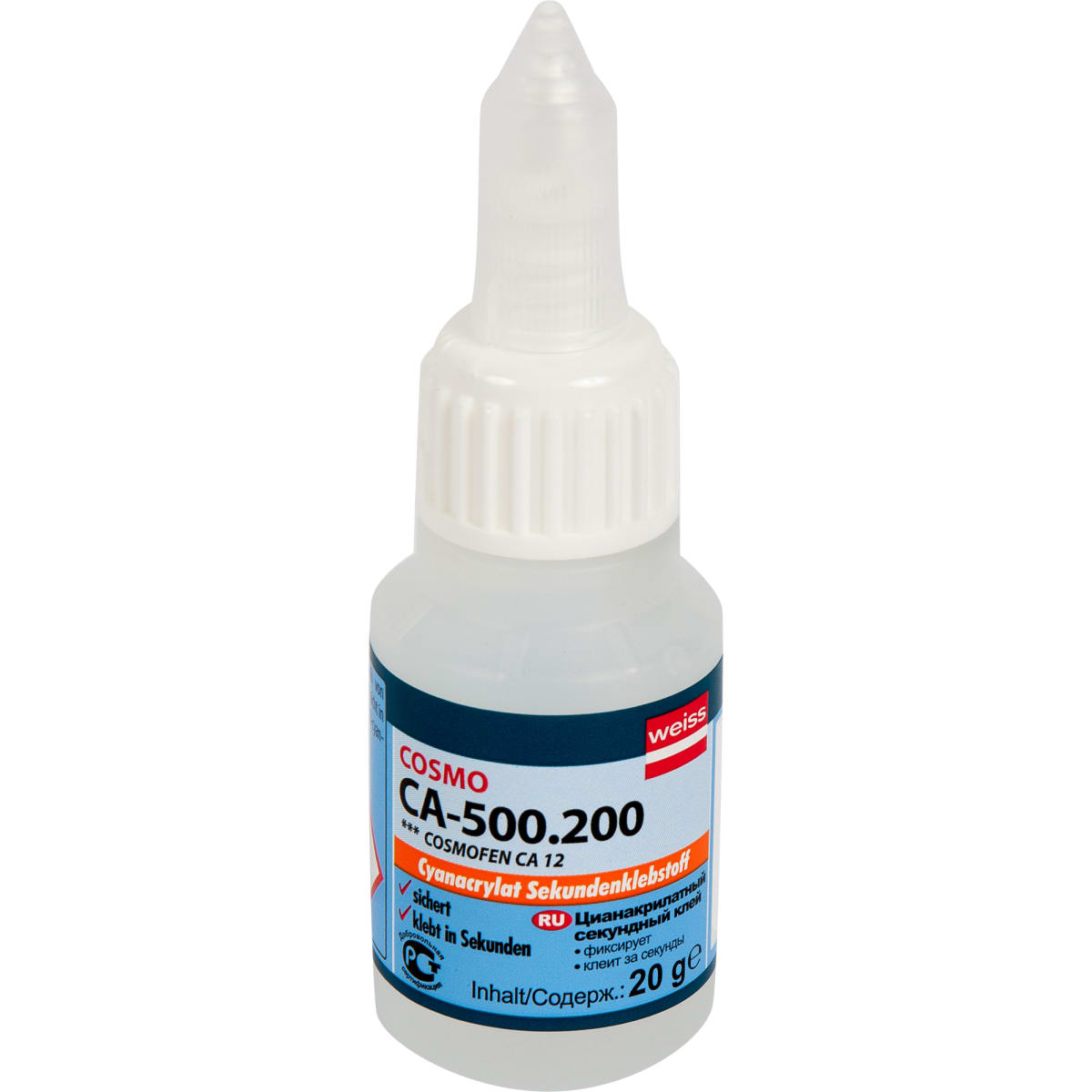Super glue properties and specifications
Superglue is often called "second glue", its feature is very fast curing in air, on the fingers. How long does superglue dry? Typically, the composition hardens in 5-60 seconds, but it takes 6-24 hours to fully cure and start operation. At low humidity, superglue curing can take up to a couple of minutes, but upon contact with water and high humidity, it occurs almost instantly.
Other properties and characteristics of the product:
- the glue firmly holds the parts even when a thin layer is applied, the main thing is to press the bases tightly;
- superglue seam withstands high loads - up to 150-250 kg / sq. cm;
- dried superglue is a semi-transparent medium elastic mass;
- most superglues can withstand temperatures in the range of -60 ... + 80 degrees, are very frost-resistant, do not react to the action of gasoline, oils, alcohol;
- some formulations not only work great in frost, but are also heat-resistant, do not deteriorate at temperatures up to +250 degrees;
- superglues without the introduction of special additives conduct current weakly and can serve as electrical insulating compounds;
- it is possible to apply funds if there are gaps of up to 0.1 mm, although some superglues have an increased viscosity, therefore they can close up gaps up to 0.25 mm (larger gaps are better filled with epoxy or polyurethane);
- the consumption of superglue is very low - a drop can cover a circle with a diameter of 2.5 cm;
- most formulations are one-part, but two-part super adhesives are also commercially available.

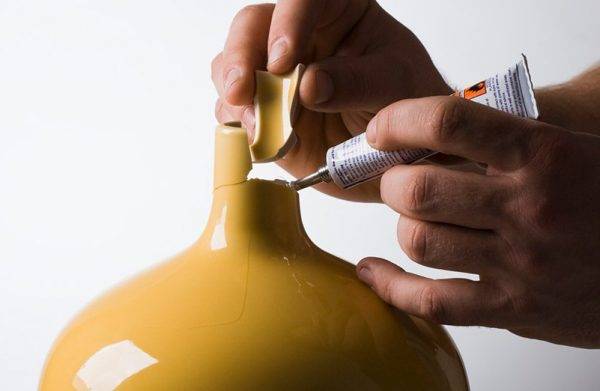
Adhesives are characterized by high adhesion to many materials, including when joining dissimilar surfaces. They are suitable for plastic, glass, wood, metal, rubber, ceramics. Super glues can be used on vertical, horizontal, inclined products. They are not suitable only for Teflon, silicone, polyethylene, it is also forbidden to glue the dishes in contact with food with them.
How to wipe off?
Excess of the applied adhesive in places not intended for gluing should be removed with a special cleaner "Cosmo CL-300.150".
Removal can be done with the well-proven Dimexidum product. A pharmacy product should be poured onto the surface stained with glue to help dissolve Cosmofen. You just have to wait a few minutes. Under the influence of "Dimexid", unnecessary glue will soften. Now it is easy to remove it with a napkin or a piece of cotton wool. If you accidentally spill a large amount of Cosmofen, then this procedure with soaking must be repeated several times. "Dimexid" is an excellent product that will never spoil either the outer surface of the processed materials or clothes. It will completely remove all glue without leaving any residue.
In order to wash off the adhesive from the hands, it is necessary to dilute "Dimexide" with water.
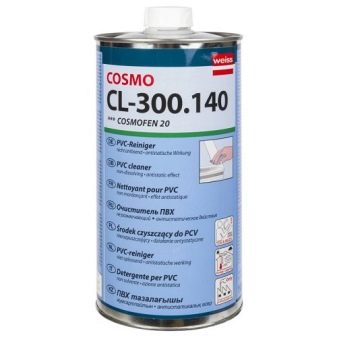

Basic rules for storing glue:
- if the temperature regime is strictly observed (from + 15 ° С to + 25 ° С), then the composition will last up to six months; at low temperatures (about +6), it will not lose its quality characteristics for up to a year;
- it is necessary to exclude high humidity around;
- the adhesive does not like the presence of direct sunlight;
- glue in damaged original packaging is stored for no more than 5 months.
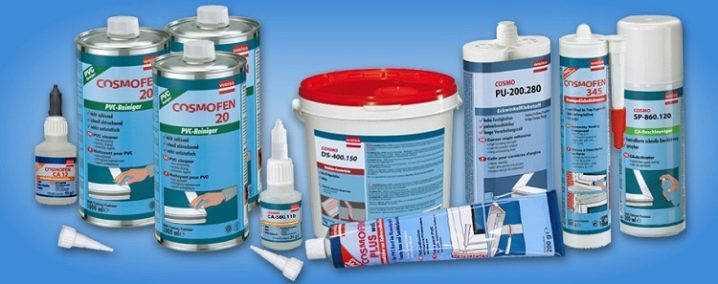
Views
One-component transparent cyanoacrylate adhesive is characterized by very fast curing under pressure. This substance forms a thin but strong film between the parts to be joined.These properties make the adhesive the best choice for high performance assembly lines. It is well used on metal and synthetic materials, including medical equipment.
A second two-component composition is much more often intended for domestic needs. Liquid mixtures, characterized by a low viscosity, can close gaps of up to 0.05 cm, and more viscous ones can close a gap of up to 0.03 cm. Two-component reagents are well suited for gluing rubber and leather products, structures made of wood chips. The more fluid the glue is, the better it is for joining hard surfaces.
The most transparent type of adhesive is designed to work with glass. And the second polymerizes in a few moments with simple contact with the moisture contained in the air (additional humidification is not required).
So, mixtures for bonding elastomers should have a tenfold lower viscosity than those intended for bonding porous products.
The main active ingredient can be various monomers:
- methyl ether helps to bind metals and duroplasts;
- Ethyl ether performs well on a variety of materials and almost does not wear out;
- butylether - just those mixtures that are needed in medical practice and special equipment;
- propylether is occasionally needed to bond metals and various parts that experience strong heat;
- Finally, alkoxyester-based cyanoacrylate adhesives do not have a negative odor, but this is achieved simultaneously with a decrease in the strength of the compounds by 20-30%.

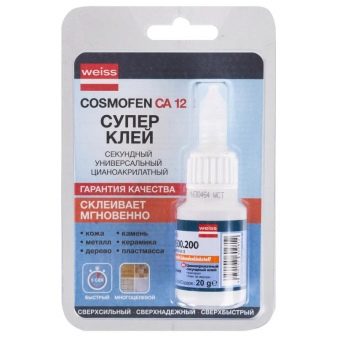
The activator must be used in an excessively dry or cold atmosphere. It is very useful when you need to close large gaps or process chemically inactive materials. The recommended spraying distance must be carefully observed to keep the surface smooth. We must not forget that certain types of activators can negatively affect thermoplastics and varnished products. It should also be borne in mind that along with the activator, it is supposed to use a primer.
The structural type of cyanoacrylate adhesive is characterized by impressive strength, heat resistance and elasticity at the same time. The recommended air humidity for it varies from 40 to 60%. The glue is applied in small portions, evenly spreading over a separate surface. The universal composition is characterized by the ability to glue dissimilar materials as quickly as possible.


Scope of application, what can they glue
In homes, such universal compounds are often present, because the need to glue various parts of objects often arises. In addition, the use of these adhesives in a manicure service is popular, in this case, acrylic compounds are chosen that do not harm the nail plate, they can be removed with organic solvents. Cyanoacrylate glue, which also adheres, is suitable for dental purposes, does not harm health, therefore it can be used to glue the chips formed on the teeth.
You can also use them for gluing elements of radio-electric devices. A number of other areas of application stand out:
- Bonding of various fabrics from natural materials, leather;
- Foam rubber;
- For plastic and thermoplastic materials;
- For production purposes, when creating wire insulation.
 In homes, such universal compounds are often present, because the need to glue various parts of objects often arises.
In homes, such universal compounds are often present, because the need to glue various parts of objects often arises.
Cosmofen: instructions for use
Clean the bonded surface from dust, degrease and wait until it dries. The glue must be applied only to one surface of the bottle using a dispenser located directly on the cap. Combine both parts of the product and hold for a while, pressing them to each other until the surfaces stick together. This is about 15-20 seconds.Final hardening depends on the ambient temperature and humidity.
COSMOFEN CA 12 glue has a low viscosity, therefore it cannot be used with a gap of more than 0.1 mm between the surfaces to be bonded. For larger gaps, COSMOPLAST 516 and COSMOPLAST 564 can be used. To speed up the curing time, COSMOPLAST 583 catalyst is used. Careful preparation must be carried out before gluing. Namely:
- aluminum parts are treated with a special chemical composition or varnished;
- silicone and plastic surfaces must be tested first, since the range of materials is quite wide, and it can be difficult to immediately select the mode and speed of gluing.
The consumption of glue is different and depends on the material. The pot life of the adhesive and the retention time of the parts under pressure are different. They can be determined experimentally, since all these processes are influenced by the structure of the material, the volume of the glued surface, as well as the temperature and humidity of the air, the thickness of the applied layer, the squeezing force and other criteria.
Cleaning of uncured COSMOFEN CA 12 is possible with COSMOPLAST 597. It is possible to clean with acetone or mechanically remove the hardened film.
When working, it is necessary to observe safety precautions. The basis glue COSMOFEN CA 12 is cyanoacrylate — the ethyl ester of cyanoacrylic acid. It is a toxic substance that also has a high adhesion rate.
It is a toxic substance that also has a high adhesion rate.
When it comes into contact with the skin, it instantly sticks together, and the eyelids can also instantly stick together. This happens within a few seconds. Avoid direct contact with the adhesive. Inhalation of the vapors sometimes causes nausea and even dizziness. If COSMOFEN CA 12 comes in contact with your skin, immediately wash off the cyanoacryl composition with soap and water. In case of contact with the eye, in no case should they be closed, you need to rinse off the glue under running water, the duration of rinsing is several minutes. After the procedure, you should immediately consult a doctor. If glue vapors are inhaled, the room must be ventilated. Fresh air will prevent poisoning.
It should be stored in places where there is no access for small children. The shelf life of the glue is six months, provided that the contents are in a container from the manufacturer in places that exclude moisture. The temperature should be in the range from + 15 ° C to + 25 °. Direct sunlight is harmful and will dry out the polymer. At a low storage temperature, for example, in a refrigerator (about plus six degrees), the shelf life is extended to 12 months.
Cosmofen cleaner for PVC windows
Cosmofen for cleaning plastic windows contains a solvent, due to which it slightly softens the surfaces to be cleaned. Esters of carboxylic acids are added to the composition, dissolving pollution.
There are 4 basic models of Cosmofen plastic cleaner. Their compositions differ in the content of active components and, as a consequence, in the type of exposure.

4 models of plastic cleaner are available: Cosmofen 5, 10, 20, 60
Cosmofen 5 (CL-300.110) is a highly dissolving cleaner containing aliphatic ketones that enhance the effect. Cosmophen solvent will remove small cracks and scratches, polish PVC surfaces, and neutralize the effects of friction.
Cosmofen 10 (CL-300.120) is a slightly dissolving cleaner, consisting only of carboxylic acid esters. It is used to prepare the PVC surface for bonding. Removes coarse dirt, writing with a marker on white PVC. This agent is distinguished by a high ignition temperature of + 460 °.
Cosmofen 20 (CL-300.140) is a non-dissolving cleaner containing aliphatic hydrocarbons plus an antistatic agent.The product cleans surfaces of various types of plastic, plastic and plexiglass. Removes contamination with resin, sealant, bitumen, rubber, polyurethane foam, writing with a pen, etc.
Usually, Cosmofen 20 cleaner is used to clean not very dirty doors and windows. The antistatic agent contained in it protects the cleaned surface from subsequent contamination for a long time.

Cosmofen 20 is used to clean not very dirty doors and windows.
Cosmofen 60 (CL-300.150) is a fast drying cleaner for anodized and painted surfaces. Removes fresh residues of glue, sealant, rubber, dirt, grease, pencil streaks, scraps of polyurethane foam, bitumen and resin.
Purifier Cosmofen: instructions for use
Cosmofen cleaning products are recommended for use on surfaces previously washed with water and dried. Then be sure to use gloves, soak the napkin with the product and wipe the surface with it as many times as necessary until it is completely shiny.
How to wipe off the cosmophen that remains superfluous? After the end of the work, it is often required to remove the remnants of inadvertently smeared glue from the laminate, stretch ceiling, from windows, linoleum, clothes

Before using the cleaner, the surface must be rinsed with water and dried
How to wash Cosmophen? There is only one way to wash off dried cyanoacrylate glue residues. This is Dimexidum. You can buy it inexpensively at any pharmacy. Dimexide must be applied directly to the dried glue residue and left to soften for a few minutes. Then they are removed with a simple cloth or bandage. Sometimes the procedure needs to be done more than once.
Dimexide is a unique remedy. It preserves the surface of all materials and perfectly removes traces of glue.

With the help of Dimexide, you can wash Cosmofen glue
How to dissolve cyanoacrylate instant glue and how to remove excess from the surface
Before starting gluing, prepare the working area to protect items that should not be processed. The dried layer cannot be removed without damaging the base, and it will not be possible to dissolve it without damage.
The surplus is removed mechanically, you can use a knife. With the sharp side, carefully remove the layer, trying to minimize the material of the product itself. Then wipe the surface with White Spirit.
If the glue solution gets on the skin, then they wait until it hardens, and carefully remove it from it. The glue does not react to gasoline, oil and solvents, so it makes no sense to use them to clean the surface from excess glue, they will not subject it to any change
Manufacturers can indicate that Dimexide can cope with the dissolution of the adhesive solution, but you should be aware that this is a toxic agent with a pungent odor. And its use must also be accompanied by compliance with safety measures so as not to get health problems. The use of a substance can also damage the surface itself, so you should check the reaction on an inconspicuous area before applying the product to the entire part.
If the glue solution gets on the skin, then they wait until it hardens, and carefully remove it from it.
Cyanoacrylate adhesives are distinguished by their fast setting and adhesion strength characteristics of a wide variety of materials and product shapes. They are easy to use and can be used in a variety of situations. The small volume of the packaging makes it possible to carry them with you. However, one should not forget that composite components can be harmful to health, therefore, safety measures should be observed when working with them. There are universal types and created for specific purposes, when choosing, you should focus on a specific task.
The history of the invention of glue
Superglue began its history in 1942. It was at this time that the American chemist G. Coover, while conducting experiments with cyanoacrylate, obtained a new substance with unique adhesive properties.Initially, the scientist did not have a goal to create glue, he worked on improving transparent plastic for optics, working for the Kodak company. Therefore, superglue as a by-product was ignored for a while.


We remembered the cyanoacrylate composition after 9 years when looking for a universal adhesive with waterproof and heat-resistant properties for aircraft construction. At that time, it turned out to be too sticky and deteriorated, even if it came into contact with moisture a little. After extensive work, Harry Coover and his colleagues have improved the composition and obtained a quality base for the glue.
Glue Cosmofen instructions for use
This glue has gained wide popularity and application due to its unique ability to quickly harden and glue various materials with high joint strength.
Cosmofen Ca 12 glue can be used for:
- high-quality gluing of parts made of polycarbonate and PVC;
- gluing polystyrene products;
- gluing plexiglass and polyethylene products;
- bonding of various fabrics, on natural or synthetic bases.
Cosmofen glue belongs to universal adhesives, but, unlike its counterparts, it has very high adhesion to various materials. The glue is moisture resistant and is not afraid of sudden changes in temperature, which greatly expands the possibilities of its use.
The best quality of Cosmofen glue
Clay Cosmofen Ca 12 and its capabilities:
The glue quickly and efficiently glues the necessary parts. Provides high seam strength
It is also important that no devices are needed to apply glue to the glued surfaces, it is applied using a standard bottle.
To fix the surfaces during gluing, it is quite enough to press hard, after applying the adhesive, and hold for about five seconds. While most adhesives reach their maximum strength after 24 hours, Cosmofen glue reaches this value in 14-16 hours.
Cosmofen even glues metals, but at the same time it is necessary to remove rust and thoroughly degrease them.
Cyanoacrylate adhesive is extremely convenient, practical and economical. A few grams are enough for gluing.
The advantage is the absence of a second component for accelerated hardening.
All the necessary substances are in the mixture.
The release of glue in small-sized bottles is an absolute plus. You can always have the bottle with you and use it whenever you need it for gluing.
A few grams are enough for gluing. The advantage is the absence of a second component for accelerated hardening.
All the necessary substances are in the mixture.
The release of glue in small-sized bottles is an absolute plus. You can always have the bottle with you and use it whenever you need it for gluing.
Cosmofen - specifications
Cosmofen universal glue technical characteristics, which are quite high, are listed below.
The mixture is based on ethyl cyanicrylate, which makes it possible to obtain a colorless, transparent seam after complete crystallization.
If the temperature is equal to or higher than +20 degrees, the glue completely cures in 16 hours, but with high humidity it takes more time. The lower temperature limit at which Cosmofen can be used is +5 degrees.
The glue goes on sale in tubes weighing from 20 to 50 grams.
Fields of application of Cosmofen Ca 12 glue
Universal glue Cosmofen technical characteristics, which provide gluing of parts from: MDF; plastic; skin; metal; the size of parts during connection is unlimited, provided that a fixed connection is created
It is important that this glue cannot be used to create elastic seams.
How to use Cosmofen correctly
- To ensure the shortest possible glue hardening time, the temperature should be at least + 20 degrees, and the humidity should be up to 60%.
- The fastening of the parts to be glued takes place after a few seconds, but complete solidification occurs only after 16 hours.
- You can glue any surfaces, the seam will be colorless and invisible.
- It is often used for shoe repair because it provides reliable bonding of materials used in the shoe industry.
- Cosmofen has a wide temperature range from 5 to 80 degrees with a plus sign. This is the effective range of the glue. In addition, the high degree of adhesion permits the bonding of metal parts. The quality of gluing directly depends on the processing (degreasing) of the parts to be glued.
Glue Cosmofen instructions for use
Cosmofen 10 is used as a solvent cleaner in window production, when working with PVC profiles. There is no worthy substitute for it when preparing surfaces before gluing and when removing stains of any complexity. Perfectly cleans plastic surfaces of aprons and boards made of polyvinyl chloride. It is antistatic.
How to work with Cosmophen 10
- Application to a cleaned and well-dried surface is carried out using lint-free wipes.
- In case of severe contamination, treatment is carried out with a Cosmofen 20 cleaner from the same manufacturer.
- The room must be dry.
- Usually, the dirt is removed with one swipe of the napkin.
- If there is a need for repetition, then polishing is carried out with Cosmofen polish.
Storage of the drug in its original packaging is allowed for 12 months after the date of manufacture. Temperature from +5 to + 26 degrees.
Cyanoacrylate glue - features and composition of the substance
Cyanoacrylic adhesive stands out for its good adhesion properties to a wide variety of substrates. This property is achieved by using copolymers in superglue. They can be two-component and one-component. At the same time, each manufacturer creates its own recipe in order to obtain special properties, the companies do not disclose the rules for the preparation of their product.
A distinctive feature of adhesives based on cyanoacrylate is the ability to glue elements of different texture and materials. In this case, the coupling will serve for a long time.
In addition to cyanoacrylate, plasticizers and thickeners can be added to the solution; they lead to additional characteristics: moisture resistance, adhesion and resistance to various temperatures. To improve vibration resistance, abietic acid combined with glycerin is added.
 Cyanoacrylic adhesive stands out for its good adhesion properties to a wide variety of substrates.
Cyanoacrylic adhesive stands out for its good adhesion properties to a wide variety of substrates.
Cyanoacrylate glue can be used for vertical and horizontal surfaces without dripping over them. The following substances can also be used in super glue:
- Ethyl ether, goes well with various materials, has high wear resistance;
- Methyl ether is suitable for creating an adhesive layer for metal and thermoplastic products;
- Butyl ether, adhesives are intended for medical devices and other special equipment;
- Propyl ether, can be used for cases when the desired product will be operated under the influence of high temperature indicators;
- Alkoxy ether helps to obtain a solution that does not exude an unpleasant odor, but the quality of adhesion decreases to 30%.
It is best to spray cyanoacrylate adhesive at low temperatures and humidity. At the same time, the required distance for spraying the agent is strictly observed.
 Cyanoacrylate glue can be used for vertical and horizontal surfaces without dripping over them.
Cyanoacrylate glue can be used for vertical and horizontal surfaces without dripping over them.
Technical characteristics and properties of the adhesive
Such adhesives can withstand, without changing their properties, the effects of water, gasoline, oil and various types of alcohols. They are produced by many companies.
Cyanoacrylate second glue allows you to properly glue small flaws in 0.1 millimeter. It is permissible to use for joining products that must be tightly adjacent to each other.On the market, you can find compositions with better viscosity, coping with gaps of up to 0.25 millimeters.
Cyacrylic adhesive has the following properties:
The viscosity is dense, the consistency is thick
As a standard, adhesives are transparent, but other options can be found;
Adhesive solutions are packaged in a container to ensure tightness, it is accompanied by rules of work and safety, which are important to observe when gluing;
The curing process, at low humidity, the curing time will take seconds, at high humidity, the coupling occurs instantly;
The temperature indicators that the adhesive layer can withstand, usually these figures vary from -60 to +80 degrees .. Cyanoacrylate second glue allows you to qualitatively glue small flaws in 0.1 millimeter.
 Cyanoacrylate second glue allows you to properly glue small flaws in 0.1 millimeter.
Cyanoacrylate second glue allows you to properly glue small flaws in 0.1 millimeter.
Varieties
Adhesives of this brand are divided into two main types: one-component and two-component compositions. Each of them has its own properties and characteristics.
Cosmofen CA 12
Cosmofen CA 12 glue is produced on the basis of modified cyanoacrylate. It is used for quick connection of plastic, metal, rubber products. Resists the effects of temperature extremes, moisture.
It is used in the production and repair of:
- Sewer, sealing systems.
- Household appliances, footwear, optical products.
- Industry: electronics, electrical, jewelry, etc.
Fixation and adhesion occurs quickly, adhesion to most surfaces is ensured. Not influenced by solar radiation.
Drying time depends on the following factors:
- Type of surfaces to be glued.
- The thickness of the adhesive mixture applied.
- Creation of the necessary conditions.
Cosmofen CA 500
This type of adhesive provides strong adhesion to all types of surfaces. Produced in a plastic container with a convenient tip. For spot, economical application on the surfaces to be glued. Used in industry mainly for bonding plastic and rubber parts. In the production of windows, it is suitable for gluing rubber seals.
Basic properties:
- Strong, fast bonding.
- After drying, a transparent hard glue line is formed.
- Increased resistance to weathering.
- Thermal stability.
- Not influenced by sunlight.
- Suitable for bonding porous surfaces.
- The composition does not include solvents.
The application is widespread in industries: optical, jewelry, electrical, footwear, automobile, aircraft, shipbuilding.
Other adhesives
In addition to the listed adhesives Cosmofen, the company produces other types:
- Cosmophen liquid plastic - glue is suitable for working with plastic windows. It is capable of joining broken window pieces of varying thickness. The mixture also acts as a sealant. It fills openings, gaps, cracks on various planes. One-component composition with low viscosity. When applying, the fact of quick fixation is taken into account, so there is no time to correct defects. The seam resists the effects of temperatures, has low thermal conductivity, high resistance to external conditions.
- Cosmofen 345 is a mass for quick gluing of wood, stone, concrete, etc. It is used as a joint sealant, since after drying, the joint is flexible, resistant to weather conditions and solar radiation. Low shrinkage, no dripping when applied vertically. It is applied to a previously cleaned surface. During the working period, use the means of IZ, exclude sources of open fire.
- Cosmofen DUO is a professional, two-component adhesive composition. It is used for gluing painted aluminum in the production of windows and doors. The composition does not contain solvents, does not spread, after complete drying, the coating can be painted.When exposed to sunlight, a change in tone may occur, but this does not affect the loss of properties.
- Cosmofen PMMA is an adhesive mass in the production of which a solvent is used. It is used for quick fastening of acrylic surfaces, in the production of display cases, stands for exhibitions, stands, etc. Provides high adhesion and strength. Durable with constant use of the bonded parts of the structure.

